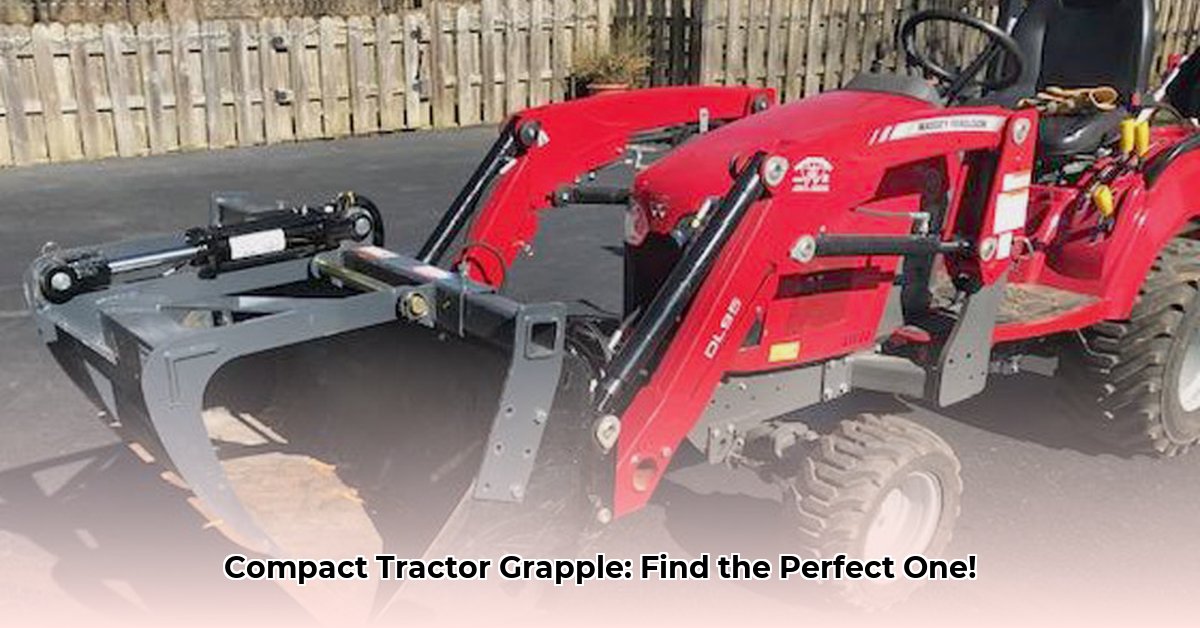
Compact Tractor Grapples: Choosing the Right Tool for Your Farm
Selecting the ideal compact tractor grapple significantly impacts farm efficiency. This review compares two popular models—the Wicked Grapple and the Homestead Implements Sub-Compact—to help you choose the best fit for your needs and tractor capabilities. We'll delve into their features, strengths, and weaknesses, ultimately guiding you towards a more informed purchasing decision. For more on tractor implements, check out this helpful resource on compact tractor implements.
The Wicked Grapple: A Powerful Performer
The Wicked Grapple is marketed as a robust, heavy-duty solution for demanding tasks. Constructed from high-strength Hardox AR450 steel and reinforced DOM tubing, it's designed to handle dense brush, stubborn tree stumps, and heavy debris. Its aggressive tine design ensures a powerful grip, allowing for efficient material handling. While the manufacturer's claims emphasize durability and versatility, the provided information lacks specifics on weight and pricing, hindering a complete comparative analysis.
Pros:
- Exceptional Durability (high-strength steel construction promises extended lifespan).
- Versatile Performance (capable of tackling a wide range of demanding tasks).
- Powerful Grip (aggressive tines provide superior material handling).
Cons:
- Weight Unspecified (limits compatibility assessment with various tractors).
- Pricing Unclear (prevents accurate cost-benefit analysis).
The Homestead Implements Sub-Compact Grapple: Agility and Efficiency
The Homestead Implements Sub-Compact grapple prioritizes maneuverability and efficiency, making it a suitable choice for smaller tractors and operations. Weighing 190 pounds, it's designed for tractors under 25 horsepower with a 1,000-pound lift capacity. Despite its lighter build, it features Hardox® 450 steel construction for durability. Its ideal applications include moving fence posts, clearing light brush, handling smaller rocks, and managing smaller logs. However, compatibility limitations exist; it isn't compatible with all loaders, such as Kubota BX pin-on loaders. Its 54-inch working width is also narrower than the unspecified width of the Wicked Grapple.
Pros:
- Lightweight Design (enhances maneuverability, particularly beneficial for smaller tractors).
- Ideal for Smaller Tractors (ensures safe and efficient operation within horsepower limitations).
- Durable Construction (high-quality steel maintains reliable performance despite lighter weight).
Cons:
- Limited Tractor Compatibility (verify compatibility before purchase; not suitable for all compact tractors).
- Smaller Working Width (reduces efficiency when handling larger volumes or wider materials).
- Lower Capacity (not designed for the heaviest tasks or largest materials).
Comparative Analysis: Wicked vs. Sub-Compact
Choosing between these grapples hinges on your specific needs and tractor capabilities. Here's a direct comparison:
| Feature | Wicked Grapple | Sub-Compact Grapple |
|---|---|---|
| Steel | Hardox AR450 | Hardox® 450 |
| Weight | Unspecified | 190 lbs |
| Horsepower Range | Unspecified | 15-25 HP |
| Lift Capacity | Unspecified | 1000 lbs |
| Ideal Tasks | Heavy-duty brush clearing, log handling | Light brush clearing, fence post moving |
| Compatibility | Unspecified | Universal Quick-Attach (SSQA), but not all loaders |
The Wicked Grapple appears better suited for larger farms needing to handle heavy materials and strenuous tasks. Conversely, the Sub-Compact Grapple is a cost-effective and maneuverable option for smaller farms and lighter workloads.
Making the Right Choice: A Step-by-Step Guide
- Assess Tractor Capabilities: Check your tractor's horsepower, lift capacity, and hydraulic flow rate.
- Define Your Tasks: Identify the types of materials you'll be handling (brush, rocks, logs, etc.).
- Consider Budget: Evaluate the cost of each grapple, factoring in potential long-term maintenance costs.
- Check Compatibility: Verify compatibility with your tractor's loader and attachment system.
- Read Reviews: Consult online reviews and forums for user feedback on both grapple models.
- Weigh Pros and Cons: Re-evaluate each grapple's features, weighing pros and cons in relation to your needs.
Following these steps will increase the likelihood of selecting the best grapple for your specific agricultural needs. The availability of more detailed specifications (like weight and pricing) would improve the decision-making process significantly. Further research into specific models may be beneficial.